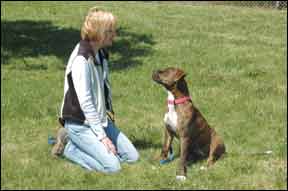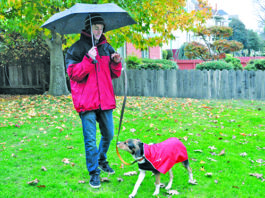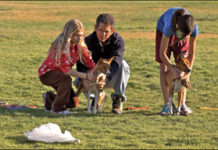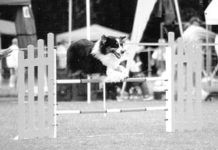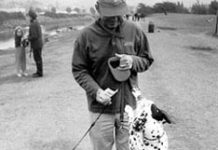Put A Stop to Door-Darting Dogs
Door darting is an impulse-control problem. It's also incredibly self-rewarding. Remedying the issue requires teaching the dog to exhibit self-control around an open door, while employing diligent management to prevent the rehearsal of unwanted behavior. The following tips can help.
5 Easy Tricks to Teach Your Dog
The list of possible tricks to teach your dog is endless. Here are five simple ones that can help get you started.
Tethering Your Dog for Training
For many years, I have been a vigorous and vocal opponent of keeping dogs tied or chained as a primary means of confinement. The hazards of tying a dog are well-documented, and include increased aggression, vulerability to human and non-human intruders, and the risk of hanging or choking. It may come as a surprise, therefore, to know that I regard the tether as an invaluable piece of training equipment. The difference and it's a big one is in the application.
Lure Coursing: Is Your Dog Up for the Chase?
For just a minute, imagine you are a dog, a predator animal, with thousands of years of selective breeding to gaze upon the horizon and chase anything that moves. Let yourself feel the anticipation of that initial sighting and the blast of adrenalin as you take off and tear up the ground between you and your prey. Your front feet and your rear feet meet under your body as you coil tightly before exploding into full stride. As you hit top speed, your stride lengthens, enabling you to run 30-plus miles per hour. There is nothing you would rather be doing. The world outside your chase ceases to exist. You are in your element. This is lure coursing. You don't need to be a sighthound to experience the thrills of a good chase, but if you are, you are built for speed off the start line, resilience to overheating, and a reluctance to give up the chase. If you are a terrier with similar predatory instincts, you'll do fine as well. If you are a bit on the bigger, heavier side, you might enjoy the chase just as much, but you'll be slower and tire more quickly.
Dog Athlete Massages for Pre- and Post-Activity
Dogs love a good massage. If you don't believe me, ask any dog. Slow rhythmic massage moves can improve circulation, reduce stress, and relieve discomfort from a recent injury or a chronic condition like arthritis. But there is another type of massage that we sometimes overlook. Prior to a competition, an invigorating sports massage can do wonders to get a canine athlete physically pumped and mentally psyched. This is true for any competitive endeavor whether it is lure coursing, agility, obedience, Frisbee, fly-ball, tracking, herding, field trials, or some other activity. After the competition, the dog can definitely benefit from another, more relaxing sports massage.
Houseguest Etiquette for Dogs
Those of us who love dogs tend to assume that everyone else in our circle of friends and family does, too. Sadly, that's not always the case. In fact, even those who do share our passion for canine companions don't always appreciate the over-enthusiastic attentions of a happy hound, especially when they are trying to enjoy the company of human friends in the comfort of a private home. Whether you are a visitor bringing your own beloved dog with you to someone else's house, or a host greeting friends at your own front door with your canine family members milling about your feet, here are some tips to help you make sure your dog/human visits go well.
Off Leash Training
How to train your dog to reliably work off leash: First get solid responses to your cues on leash, then on a long line. When moving to an unfenced area, introduce distractions gradually.
How to Stop Lunging Behavior
My nine-month-old Bouvier puppy is in training, but I am having trouble finding a positive way to stop his lunging; he is very strong. I am using a choke chain, and my current trainer feels I'm not firm enough in my corrections. I don't feel comfortable using the choker, but also don't like the idea of the Halti because it might be even more dangerous if he lunged.
Your Dog’s Behavior: When to Manage, When to Train
How do I stop my dog from stealing food? How do I get my dog to stop drinking toilet water? Why does my dog run off all the time? These are just a few of the countless things dogs do that make their guardians run to professional trainers for help. The reality of dog behavior modification is that often the solution to a dog's bad habit is not through training the dog, but through carefully managing every opportunity the dog has to practice unwanted behaviors.
Tracking Your Dog’s Training Progress
Lately, it seems like there's an epidemic of people around me who can't see their own and their dog's progress. In a similar vein, I've been surprised by the number of clients who seem to take their dog's improvement for granted, yet continually expect more and more.
Some Great Leash-Walking Products
The best leash-walking products are effective in helping the owner train the dog not to pull (that is, they provide a large enough window of opportunity for the owner to successfully train the desired walking behavior), minimally aversive to the dog, easy to use, well-made, and affordable. (We put price last, since most owners of leash-pulling dogs would pay almost anything for a product that really helps them!)
5 Professional Dog Training Tips
Yes, raising and training a puppy takes work, but it doesn't need to feel overwhelming at least, not the majority of the time! The more you know, the easier it gets. As I think about my own approach to raising and living with dogs, and that of many of my colleagues, I realize we engage in numerous behaviors that are extraordinarily helpful yet it's often difficult to get the pet owners we work for to try them! Don't resist! The following five tips can help you train like a pro.


